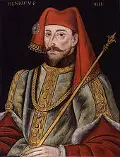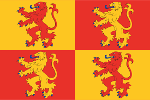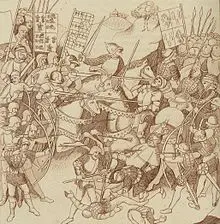King Henry IV of England
King Henry IV was the grandson of a king and the child playmate of that king's successor. He gained the throne through abdication and kept it by putting down revolt after revolt. All of this took place against the backdrop of the Hundred Years War. He was born on April 4, 1366, at Bolingbroke Castle, in Lincolnshire. His father was the famous John of Gaunt, whose father was King Edward III. His mother was Blanche, whose family owned the Lancaster estates. 
Henry eventually deposed King Richard II, but the two had a long history together, starting as childhood playmates. They were both grandsons of the late king: Richard's father was Edward the Black Prince. Richard and Henry joined the Order of the Garter together in 1377, the year that Richard was crowned king. A decade later, however, things had changed. Henry, as one of the advisory council the Lords Appellant, joined the rebellion of Thomas, Duke of Gloucester against Richard in 1387 but escaped unscathed after the king restored his favor. After a brief sojourn in Lithuania serving with the Teutonic knights, Henry went to Prussia and then the Holy Land. (He made a pilgrimage to Jerusalem in 1392.) When he returned, having been dispossessed by Richard, he joined the opponents of the king, among them his father and Gloucester. 
In 1398, Richard banished Henry and Thomas de Mowbray in order to stave off a feud that Richard feared would descend into a wider conflict. (Henry he banished for a decade; Thomas he banished for life.) A year later, John of Gaunt died and Richard refused to allow his son, Henry, to succeed him, in title or in lands or possessions. An Angry Henry returned at the head of a popular uprising and forced Richard to abdicate. Henry took the throne on Sept. 30, 1399 and was crowned at Westminster Abbey on October 13. The new king sent the previous king into imprisonment, where he later died, many historians think of starvation. He died in Pontefract Castle in 1400. 
Henry found that the allies he had counted on to support his claim to the throne had their own designs on power. He faced a series of rebellions during his reign, including one by Richard's supporters not long after the coronation. As the 15th Century dawned, Owain Glyndŵr had himself declared Prince of Wales and gathered together a combined Franco-Spanish-Welsh force to challenge the supremacy of England. Henry put down this rebellion after a number of years. 
Henry also faced down a rebellion by the Welsh allies Henry Percy and his father, the Earl of Northumberland, culminating in the Battle of Shrewsbury in 1403, and another, headed by Mowbray and the Archbishop of York two years later. Northumberland was still on the loose and was at the head of another rebellion, this one in 1408; the Battle of Bramham Moor again saw Henry's forces victorious. Northumberland was finally defeated, about the same time that Henry's forces finally subdued the Welsh as well. The Scottish threat ended when England captured James, the heir to the Scottish throne. The main arbiter of the king's success in putting down these rebellions was the military prowess of his son, Henry, the heir to the throne. The king also benefited from a lull in the Hundred Years War, as France was at this time consumed with its own internal power struggles. The king faced many pressures from both Parliament and the Church. Among his concessions to the Church was the passage of a law that allowed for the burning of heretics, a measure aimed at stopping the spread of the Lollard movement, led initially by famed Reformationist John Wycliffe. He also depended for military funding on Parliament, which insisted on appointing a governing council that Henry grudgingly accepted, in 1406. His one faithful friend through his time on the throne was Archbishop Arundel. Henry married twice, to Mary de Bohun in 1380 and then in 1403 (Mary having died in 1394) to Joan, the daughter of Charles II of Navarre. In all, Henry and Mary had six children: two daughters and five sons, including the eventual Henry V. Henry had a painful last decade, marked by serious illnesses. He contracted a skin disease that disfigured him and suffered through a series of debilitating battles with another mysterious illness, on and off, beginning in June 1405 and flaring up again in April 1406, June 1408, late 1408 and early 1409, December 1412, and March 1413. Historians still do not agree on the specifics of the illness. 
He died on March 20, 1413, and was buried not at Westminster Abbey, as had been the custom for many of his predecessors, but at Canterbury Cathedral, in order to near the shrine of Thomas Becket, the archbishop who had had been murdered there by followers of King Henry II on Dec. 29, 1170. Henry was particularly devoted to what was then the burgeoning cult of Becket. Henry's oldest son, also named Henry, was crowned king. The two men had been at odds for the past few years, particularly over what course to take in France, where the Hundred Years War had continued. Among other things:
|
|
Social Studies for Kids
copyright 2002–2025
David White




